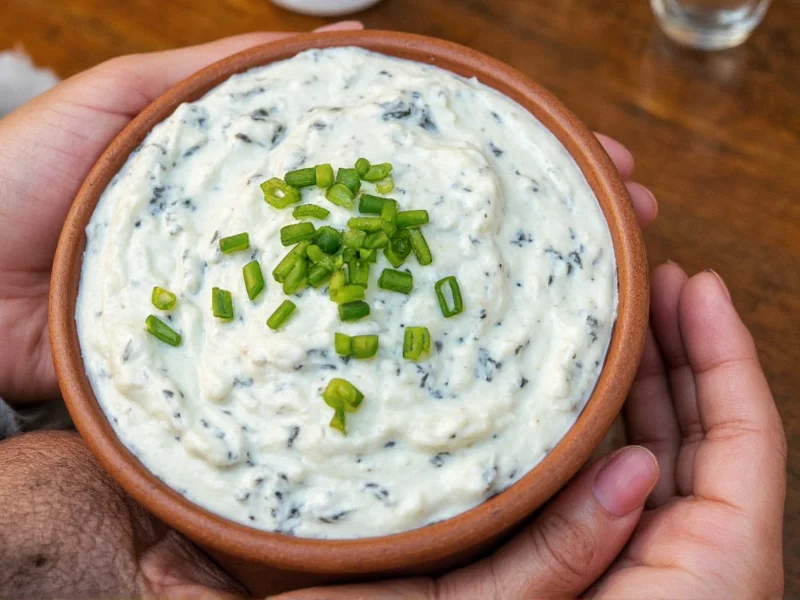Tzaziki represents one of the most beloved elements of Greek cuisine, offering a cooling contrast to grilled dishes and rich flavors. This simple yet sophisticated sauce has traveled far beyond its Aegean origins to become a staple in Mediterranean restaurants and home kitchens globally. Understanding tzaziki means appreciating both its culinary function and cultural significance within Greek food traditions.
Historical Origins and Cultural Significance
While often associated with Greek cuisine, tzaziki's roots extend across the Eastern Mediterranean region. The word "tzatziki" (τζατζίκι) derives from the Turkish "cacık," which itself has Persian origins. However, the version most familiar to Western palates is distinctly Greek, perfected over centuries as part of the country's culinary heritage.
In Greece, tzaziki isn't merely a condiment—it's an essential component of meze (appetizer) culture. Traditional Greek households often prepare tzaziki daily during warmer months, serving it alongside grilled octopus, souvlaki, or simply with fresh bread. The sauce's cooling properties made it particularly valuable in Greece's hot climate, providing relief from summer heat while complementing the region's abundant grilled foods.
Traditional Ingredients and Their Purpose
The magic of authentic tzaziki lies in its simplicity and quality of ingredients. Each component serves a specific purpose in creating the perfect balance of flavors and textures:
| Ingredient | Traditional Amount | Function |
|---|---|---|
| Full-fat Greek yogurt | 2 cups | Provides creamy base and tangy flavor |
| English cucumber | 1 medium | Adds freshness and cooling element |
| Fresh garlic | 2-3 cloves | Delivers signature aromatic punch |
| Extra virgin olive oil | 2 tbsp | Enhances richness and mouthfeel |
| Fresh dill or mint | 1-2 tbsp chopped | Provides herbal complexity |
| Lemon juice or red wine vinegar | 1 tbsp | Brightens flavors and balances richness |
Preparation Techniques for Authentic Flavor
Creating exceptional tzaziki requires attention to technique as much as ingredients. The most critical step involves properly preparing the cucumber. Traditional preparation demands:
- Peeling and finely grating the cucumber
- Squeezing out excess moisture using a clean kitchen towel
- Allowing the mixture to rest for several hours or overnight
This resting period allows the flavors to meld while the yogurt's natural enzymes slightly ferment the mixture, developing more complex flavors. Many Greek chefs insist that tzaziki tastes significantly better the day after preparation, as the garlic mellowing and flavors fully integrate.
Variations Across the Mediterranean
While Greek tzaziki remains the most internationally recognized version, similar preparations exist throughout the Mediterranean and Middle East:
- Turkish cacık typically includes more garlic and sometimes walnuts
- Lebanese jajeek often incorporates mint more prominently
- Bulgarian tarator sometimes includes walnuts and dill
- Iranian mast-o-khiar features more herbs and sometimes rose petals
These regional variations demonstrate how tzaziki's basic formula has adapted to local tastes while maintaining its essential character as a refreshing yogurt-based condiment.
Nutritional Profile and Health Benefits
Tzaziki offers notable nutritional advantages compared to many Western-style dips and sauces. Its primary ingredient—Greek yogurt—provides:
- High-quality protein (approximately 5g per ¼ cup serving)
- Probiotics that support gut health
- Calcium for bone health
- Lower fat content than mayo-based alternatives
The cucumber contributes hydration and trace minerals, while garlic offers allicin compounds with potential anti-inflammatory properties. When prepared with quality olive oil, tzaziki also delivers heart-healthy monounsaturated fats. This nutritional profile makes tzaziki an excellent choice for those seeking flavorful yet health-conscious condiments.
Serving Traditions and Modern Applications
Traditionally, tzaziki accompanies grilled meats like souvlaki and gyros, acting as both flavor enhancer and digestive aid. In Greek dining culture, it's commonly served with:
- Lamb chops and grilled chicken
- Fresh vegetables and pita bread
- As part of a complete meze platter
- Alongside fried calamari
Modern culinary applications have expanded tzaziki's versatility significantly. Contemporary chefs use it as:
- A sandwich spread replacing mayonnaise
- A vegetable dip for crudités
- A sauce for grain bowls and salads
- A topping for baked potatoes
- A base for salad dressings
Common Preparation Mistakes to Avoid
Even experienced cooks sometimes make errors that compromise tzaziki's quality. The most frequent issues include:
- Using regular yogurt instead of thick Greek yogurt
- Skipping the crucial step of removing cucumber moisture
- Adding garlic that's too freshly minced (allow it to mellow)
- Using dried herbs instead of fresh
- Serving immediately rather than allowing flavors to develop
For optimal results, always use full-fat Greek yogurt, thoroughly drain the cucumber, and allow the mixture to rest for at least four hours before serving. The patience required for proper tzaziki preparation yields significantly better flavor and texture.
Storage and Shelf Life
Properly stored tzaziki maintains quality for 4-5 days in the refrigerator. Key storage tips include:
- Store in an airtight container
- Keep away from strong-smelling foods
- Stir well before serving if separation occurs
- Do not leave at room temperature for more than two hours
The yogurt base means tzaziki will continue to develop tanginess over time. While this enhances flavor for some palates, extremely long storage may make the sauce too sour for general enjoyment.











 浙公网安备
33010002000092号
浙公网安备
33010002000092号 浙B2-20120091-4
浙B2-20120091-4